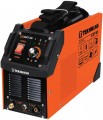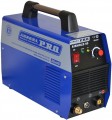Minimum input voltage
The minimum actual input voltage at which the welding machine remains operational.
Such information is useful primarily for working in unstable networks, where the voltage tends to “sag” a lot, as well as from autonomous power sources (for example, generators), which can also produce voltage below the nominal one.
Power consumption
The maximum power consumed by the welding machine during operation, expressed in kilowatts (kW), that is, thousands of watts. In addition, the designation in kilovolt-amperes (kVA) can be used, see below for it.
The higher the power consumption, the more powerful the current the device is capable of delivering and the better it is suitable for working with thick parts. For different materials of different thicknesses, there are recommendations for current strength, they can be clarified in specialized sources. Knowing these recommendations and the open circuit voltage (see below) for the selected type of welding, it is possible to calculate the minimum required power of the welding machine using special formulas. It is also worth considering that high power creates corresponding loads on the wiring and may require connection directly to the shield.
As for the difference between watts and volt-amperes, the physical meaning of both units is the same — current times voltage. However, they represent different parameters. In volt-amperes, the total power consumption is indicated — both active (going to do work and heat individual parts) and reactive (going to losses in coils and capacitors). This value is more convenient to use to calculate the load on the power grid. In watts, only active power is recorded; according to these numbers, it is convenient to calculate the practical capabilities of the welding machine.
Power consumption
Power consumption of the welding machine, expressed in kilovolt-amperes.
kVA is a unit of power used in welding machines along with the more traditional kilowatts. The physical meaning of both units is the same — current multiplied by voltage; however, they denote different parameters. So, in kilowatts, only a part of the total power consumption is recorded — active power (goes to do work and to losses due to heating of individual parts); according to this indicator it is convenient to calculate the practical capabilities of the device. And kilovolt-amperes denote the total energy consumption — it also takes into account reactive power (it goes to losses in coils and capacitors during the operation of alternating current circuits). This data is useful for calculating the total load on the network or other power source.
The apparent power input in kVA will always be greater than the power in kW. However, some manufacturers go to the trick and indicate full power not at full, but at partial (for example, half) load. This gives the impression of efficiency, but is incorrect from a technical point of view. As for the ratio of energy consumption, the active power in kW is often 20-30% lower than the apparent power in kVA. So, in terms of kilovolt-amperes, it is quite possible to evaluate the performance of the unit.
As for specific values, in the most modest models they
do not exceed 3 kVA. An indicator
up to 5 kVA is considered low,
up to 7 kVA — average, and in the most powerful units, the power consumption can reach
10 kVA or even
more.
Open circuit voltage
The voltage supplied by the welding machine to the electrodes. As the name suggests, it is measured without load — i.e. when the electrodes are disconnected and no current flows between them. This is due to the fact that at a high current strength characteristic of electric welding, the actual voltage on the electrodes drops sharply, and this does not make it possible to adequately assess the characteristics of the welding machine.
Depending on the characteristics of the machine (see "Type") and the type of work (see "Type of welding"), different open circuit voltages are used. For example, for welding transformers, this parameter is about 45 – 55 V (although there are higher voltage models), for inverters it can reach 90 V, and for semi-automatic MIG / MAG welding, voltages above 40 V are usually not required. Also, the optimal values \u200b\u200bdepend on type of electrodes used. You can find more detailed information in special sources; here we note that the higher the open-circuit voltage, the easier it is usually to strike the arc and the more stable the discharge itself.
Also note that for devices with the VRD function (see "Advanced"), this parameter indicates the standard voltage, without reduction through VRD.
Max. welding current
The highest current that the welding machine is capable of delivering through the electrodes during operation. In general, the higher this indicator, the thicker the electrodes the device can use and the greater the thickness of the parts with which it can work. Of course, it does not always make sense to chase high currents — they are more likely to damage thin parts. However, if you have to deal with large-scale work and a large thickness of the materials to be welded, you simply cannot do without a device with the appropriate characteristics. Optimum welding currents depending on materials, type of work (see "Type of welding"), type of electrodes, etc. can be specified in special tables. As for specific values, in the most “weak” models, the maximum current
does not even reach 100 A, in the most powerful ones it can exceed
225 A and even
250 A.Duty cycle
The duty cycle allowed for the welding machine.
Almost all modern welding machines require breaks in operation — for cooling and general "recovery". The frequency of inclusion indicates what percentage of the time of the total work cycle can be used directly for work. In this case, 10 minutes is usually taken as a standard cycle. Thus, for example, a device with a duty cycle of
30% will be able to work continuously for less than 3 minutes, after which it will need at least 7 minutes of interruption. However, for some models, a cycle of 5 minutes is used; these nuances should be clarified according to the instructions.
In general, high frequency is required mainly for high-volume professional work; with a relatively simple application, this parameter does not play a decisive role, especially since you have to take breaks during work. As for specific values, the mentioned 30% is a very limited figure, typical mainly for entry-level devices. A value of
30 – 50% is also low; in the range of
50 – 70% is the majority of modern devices, and the most "hardy" models provide a frequency
of more than 70%.
Max. cutting thickness (PLASMA)
The largest thickness of material that the machine can cut in plasma cutting mode. For more information about this mode, see "Type of welding". Note that the maximum thickness is often given for a certain average material in terms of durability; with refractory substances, the efficiency of work may be somewhat lower (at least it will take more time to cut through).
Сutter cable
The length of the torch cable supplied with the machine.
The cutter is called the working nozzle for the PLASMA mode (plasma cutting). And the longer the wire with which such a nozzle is connected to the device, the more freedom the welder has in moving, the farther he can go without moving the device itself. On the other hand, excessively long cables create problems in storage and transportation, and often during operation (you need to look for a place where to place the excess wire). Therefore, when choosing, you should proceed from what is more important for you: the ability to move away from the device or the overall compactness. As for specific figures, in most models they are from 3 to 5 metres, although there are exceptions (in both directions).

